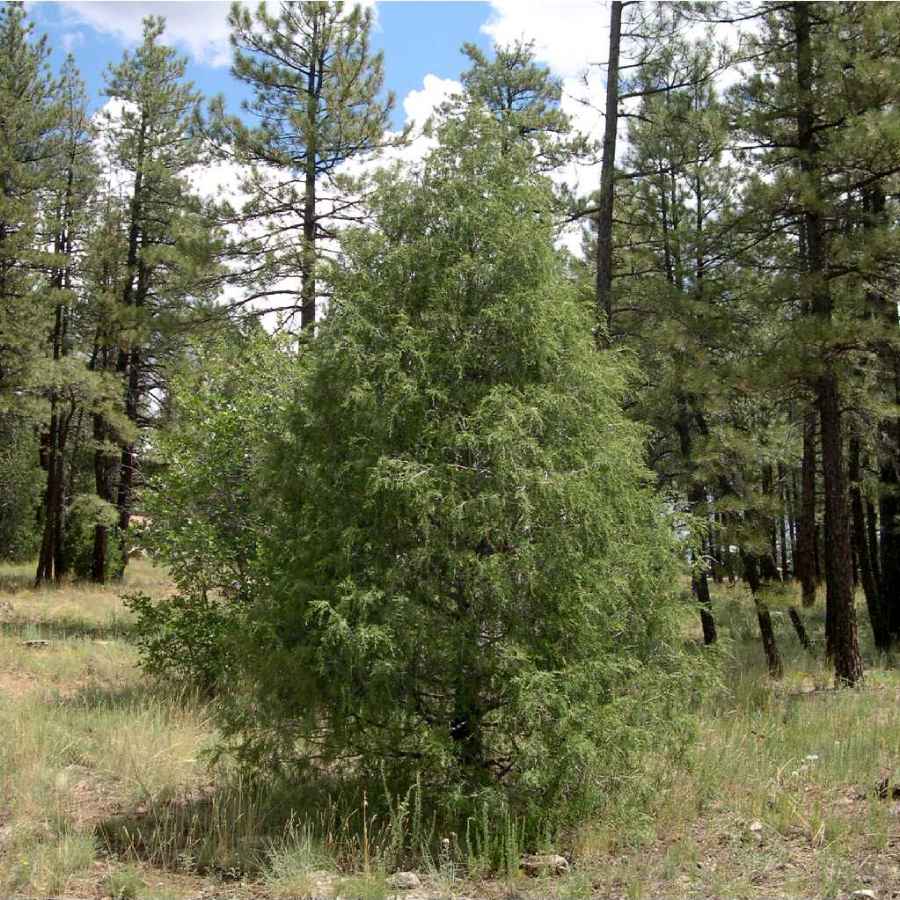- Home
- Search
- Images
- Datasets
- Sample Use
- How to Cite
- Additional Information
- About NEON
- NEON Data Portal
- ASU Biocollections
- About Symbiota
|
Cupressaceae |
|
|
Trees or shrubs evergreen (usually deciduous in Taxodium ), generally resinous and aromatic, monoecious (usually dioecious in Juniperus ). Bark fibrous and furrowed (smooth or exfoliating in plates in some Cupressus and Juniperus species). Lateral branches well developed, similar to leading shoots, twigs terete, angled, or flattened dorsiventrally (with structurally distinct lower and upper surfaces; Thuja , Calocedrus ), densely clothed by scalelike leaves or by decurrent leaf bases; longest internodes to 1 cm; buds undifferentiated and inconspicuous (except in Sequoia ). Roots fibrous to woody (bearing aboveground 'knees' in Taxodium ). Leaves simple, usually persisting 3--5 years and shed with lateral shoots (cladoptosic) (shed annually in Taxodium ), alternate and spirally arranged but sometimes twisted so as to appear 2-ranked, or opposite in 4 ranks, or whorled, deltate-scalelike to linear, decurrent, sessile or petioled; adult leaves appressed or spreading, often differing between lateral and leading shoots (twigs heterophyllous), sometimes strongly dimorphic on each twig ( Thuja , Calocedrus ) with lateral scale-leaf pairs conspicuously keeled; juvenile leaves linear, flattened, spreading; often with solitary abaxial resin gland; resin canal present. Pollen cones maturing and shed annually, solitary, terminal (rarely in clusters of 2--5, axillary in Juniperus communis ; usually in terminal panicles in Taxodium ), simple, spheric to oblong; sporophylls overlapping, bearing 2--10 abaxial microsporangia (pollen sacs); pollen spheric, not winged. Seed cones maturing in 1--2 seasons, shed with short shoots or persisting indefinitely on long-lived axes (shattering at maturity in Taxodium ), compound, solitary, terminal (rarely in clusters of 2--5, axillary in Juniperus communis ); scales overlapping or abutting, fused to subtending bracts with only bract apex sometimes free; each scale-bract complex peltate, oblong or cuneate, at maturity woody or fleshy, with 1--20 erect (inverted with age in Sequoia and Sequoiadendron ), adaxial ovules. Seeds 1--20 per scale, not winged or with 2--3 symmetric or asymmetric wings; aril lacking; cotyledons 2--9. Pollination usually occurs in late winter or spring but may occur anytime from late summer to early winter for some species of Juniperus . Seed maturation occurs in late summer or autumn. Species of Cupressus have serotinous cones that remain closed for many years, some opening only after exposure to fire. The Cupressaceae, with a known fossil record extending back to the Jurassic (C. N. Miller Jr. 1988), constitute a diverse family often divided between Cupressaceae in the strict sense (for genera with leaves opposite in four ranks or whorled) and Taxodiaceae (leaves mostly alternate), but they are best kept together (J. E. Eckenwalder 1976; R. A. Price 1989). The unity of the family is best shown in the structure of the mature seed cones: the bract-scale complexes are intimately fused for most of their common length, the 1--20 ovules are erect at first but may invert with maturity, and the paired seed wings, if present, are derived from the seed coat. A majority of genera are monotypic and most others display disjunct or relictual distributions, even though individual species may be widely distributed. Only bird-dispersed Juniperus is species rich, with a wide, nearly continuous Northern Hemisphere distribution. Because of their uniformity, seedlings and juvenile specimens may not be determinable to genus. Foliage of cultivars may deviate greatly from forms found in wild plants. Although no members of the family attain dominance over immense geographic spans as do some species of the Pinaceae in the boreal forests, they can achieve considerable local and regional prominence. Examples include redwood ( Sequoia sempervirens ) along the coast of northern California, several species of Juniperus (together with pinyons) at moderate elevations in the southwestern United States and Mexico, and baldcypress ( Taxodium distichum ) in deep swamps of the southeastern United States. Their ranges and regions of dominance were considerably greater during the early Tertiary. The heartwood of many species of Cupressaceae is resistant to termite damage and fungal decay, and therefore it is widely used in contact with soil. Most prominent in the flora are redwood and baldcypress; the premier coffin wood of China, Cunninghamia lanceolata , is another member of the family. Other genera, usually called cedars, may have aromatic woods with a variety of specialty uses. Wooden pencils are made from incense-cedar ( Calocedrus decurrens ) and eastern redcedar ( Juniperus virginiana ), which is also used for lining cedar chests. Wood from species of Thuja is still used for cedar roofing shingles. In addition to the taxa treated below (including one naturalized species), several additional species and genera are cultivated to a greater or lesser extent and may persist without sp PLANT: Trees or shrubs, evergreen, monoecious or dioecious. LEAVES: decussate or tricussate (in whorls of three); awl- or needle-like to usually scale-like (juvenile leaves awl- or needle-like, sometimes present in more or less mature plants, especially in response to grazing or infection), decurrent, completely covering young stems. POLLEN CONES: small, axillary or terminal. SEED CONES: woody to more or less fleshy, usually hard at maturity; scales decussate or tricussate. SEEDS: 1 to many per fertile scale usually angled or winged. - NOTES: 17 genera, ca. 120 spp.; worldwide, all N. Amer. genera cultivated. Dallimore, W., and A. B. Jackson. 1966. A Handbook of Coniferae and Ginkgoaceae. London, St. Martin's Press; Elias, T. S. 1980. The Complete Trees of North America. New York, Van Nostrand Reinhold Co.; Rushforth, K. D. 1987. Conifers. London, Christopher Helm; Siba, J. 1984. An International Census of the Coniferae, I. Phytologia Memoirs VII:1-79. REFERENCES: Bartel, Jim A. 1994. Cupressaceae. J. Ariz. - Nev. Acad. Sci. Volume 27, 195-200. |
|

